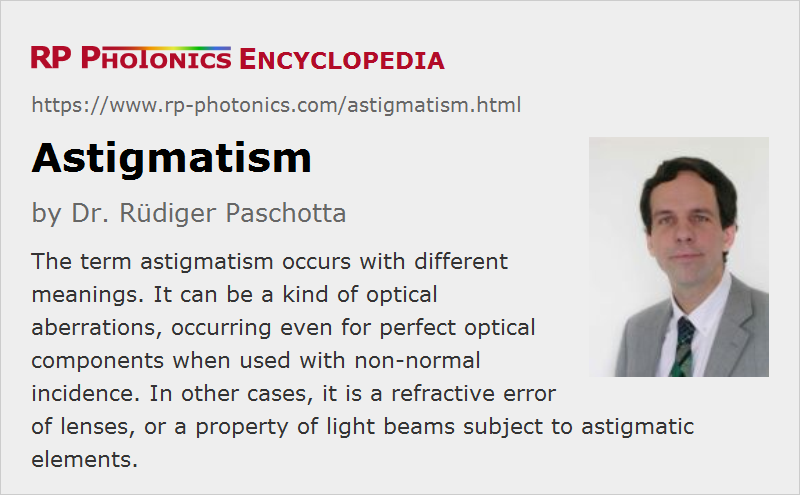Astigmatism
Definition: a kind of optical aberrations; alternatively, a defect of optical lenses or a property of laser beams
German: Astigmatismus
Categories: general optics, vision, displays and imaging
How to cite the article; suggest additional literature
Author: Dr. Rüdiger Paschotta
The term astigmatism is used with various different (but related) meanings, which are explained in the following sections.
Astigmatism as a Kind of Optical Aberrations
Astigmatism is one of the classical types of optical aberrations which are experienced in imaging systems. It occurs, for example, when light hits a spherical optical lens or a spherically curved mirror under a substantial angle against the optical axis. Here, the focal length of the optical element is essentially dependent on the direction: it is reduced in the tangential plane and increased in the sagittal plane. As a result, perfect focusing of a circular laser beam, for example, is no more possible: the smallest beam radius for the tangential direction is reached sooner than for the sagittal direction.
Obviously, that phenomenon also leads to image distortions. It can be easily observed, for example, by viewing a small dot on paper through a magnifying glass which is substantially tilted against the normal direction. Depending on the focusing conditions, the image of a point may be elongated in one or the other direction.
In contrast to spherical aberrations, for example, astigmatism cannot be reduced simply by using an optical aperture. However, if a ray bundle also fills a large part of the lens area, the problem becomes worse and is in that case called coma.
Optical systems can often be corrected in terms of astigmatism by using an appropriate combination of different lenses, for example.
Astigmatism as a Defect of an Optical Lens
Astigmatism as explained in the previous section results for geometrical reasons even for perfectly spherical mirrors and lenses.
A similar kind of problem can result even for normal incidence if a lens or mirror has a different curvature in vertical and horizontal direction. That occurs in many human eyes as a kind of refractive error; a substantial fraction of the human population more or less suffers from that problem. This problem can be quantified in terms of the difference of dioptric powers between vertical and horizontal direction. Note that astigmatism of eyes can be even more complicated; for example, there can be an oblique astigmatism with modified directions of horizontal and vertical meridian or even irregular astigmatism.
Astigmatism of human eyes can be compensated with suitable prescription glasses or remedied with refractive eye surgery (see the article on medical lasers).
An extreme case would be a cylindrical lens or mirror, which is intentionally curved only in one direction, not having any dioptric power in the other direction.
Astigmatism of Light Beams
Astigmatism is also often understood as a property of a light beam – for example, a laser beam which propagated through a cylindrical lens. In simpler cases, astigmatism of a beam means that the focal points for the vertical and horizontal direction do not coincide. That problem may be corrected with an anamorphic prism pair, for example, or with cylindrical lenses or with tilted curved mirrors.
In laser technology, one can often consider the beam evolution separately and independently for the horizontal and vertical direction. This requires that any cylindrical lenses and the like are oriented such that they affect only either the horizontal or the vertical direction.
In other, more general cases, for example with a cylindrical lens rotated by 45°, the situation becomes substantially more complicated to describe mathematically, but that rarely occurs in optics and laser technology.
Questions and Comments from Users
Here you can submit questions and comments. As far as they get accepted by the author, they will appear above this paragraph together with the author’s answer. The author will decide on acceptance based on certain criteria. Essentially, the issue must be of sufficiently broad interest.
Please do not enter personal data here; we would otherwise delete it soon. (See also our privacy declaration.) If you wish to receive personal feedback or consultancy from the author, please contact him e.g. via e-mail.
By submitting the information, you give your consent to the potential publication of your inputs on our website according to our rules. (If you later retract your consent, we will delete those inputs.) As your inputs are first reviewed by the author, they may be published with some delay.
See also: optical aberrations, lenses, cylindrical lenses, mirrors
and other articles in the categories general optics, vision, displays and imaging
 |




If you like this page, please share the link with your friends and colleagues, e.g. via social media:
These sharing buttons are implemented in a privacy-friendly way!